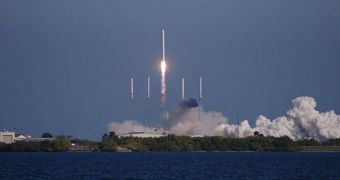Officials at the Space Exploration Technologies Corporation (SpaceX) are ecstatic over the successful completion of the maiden voyage of their unmanned Dragon space capsule.
Developed to act as a lifeline to crews aboard the International Space Station (ISS), the capsule was took off yesterday for the first time from the Launch Complex 40 facility at the Cape Canaveral Air Force Station (CCAFS), in Florida.
Mission managers had three launch opportunities on December 8, but the first one, 9:06 am EST (1406 GMT), was aborted. The space vehicle was launched during the second window, at 10:52 am EST (1552 GMT).
It took off aboard the Falcon 9 medium-lift delivery system, which was only at its second mission ever. Its maiden flight took place this June, also from the CCAFS.
A short while after the two spacecrafts took off, the Dragon separated from the second stage of its rocket, and entered a stable orbit around the planet. Hours later, it reentered Earth's orbit, and touched down in the ocean, aided by parachutes.
The probe was tracked down to a location about 500 miles (nearly 805 kilometers) off the coast of Mexico, SpaceX officials announced, quoted by Space.
Dragon spent some three hours in orbit, during which time it flew at an altitude of about 300 kilometers, receiving commands from its mission controllers. The purpose of this was to test the functionality of all its critical systems.
This is only the first of three test flights that Space X needs to conduct, according to the $1.6 billion contract it signed with NASA under the Commercial Orbital Transportation Services (COTS) program.
At this time, Dragon is the first privately-built spacecraft to have ever reentered Earth's atmosphere, an event that required a special approval from the US Federal Aviation Administration (FAA).
“It's just mind-blowingly awesome. It's hard to be articulate when your mind's blown – but in a very good way,” explained soon after the Dragon touchdown the founder and CEO of SpaceX, Elon Musk.
He added the orbital reentry has only been achieved by NASA, RosCosmos, ESA, China, Japan and India. SpaceX is the first private business to do so.
“I can't tell you how excited I am. The important thing for everybody to understand is that this is the first time that something other than a nation has done ascent, on-orbit and intact recovery,” said NASA Administrator Charles Bolden.
“What a great day for SpaceX, what a great day for NASA, and what a historic day for commercial spaceflight. This is an indication that this experiment is working. This public-private partnership has certainly shown to be successful today,” added Alan Lindenmoyer.
The NASA official is the program manager of the American space agency's Commercial Crew and Cargo Program, Space reports.

 14 DAY TRIAL //
14 DAY TRIAL //